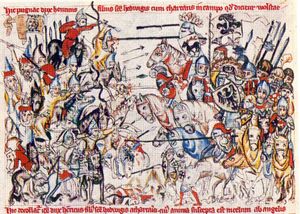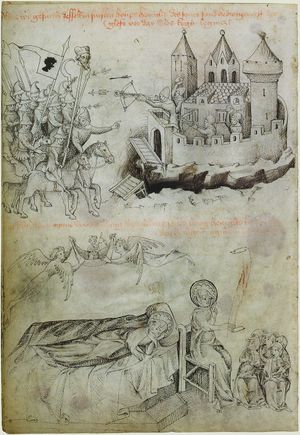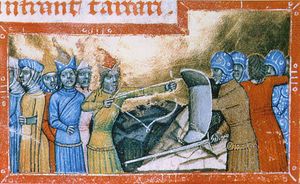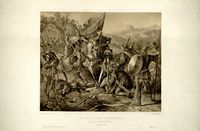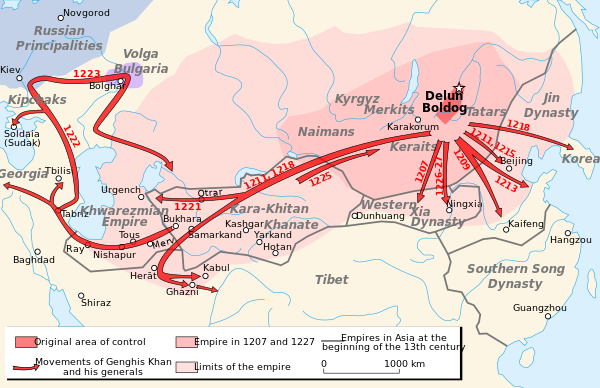الغزو المنغولي لأوروپا
| الفتوحات المنغولية في آسيا وأوروپا | |||||||||
|---|---|---|---|---|---|---|---|---|---|
 مسار أول تجريدة منغولية في روسيا - 1223 | |||||||||
| |||||||||
| المتحاربون | |||||||||
|
الامبراطورية المنغولية |
آلان الشركس شعوب شمال القوقاز ب) ج) مملكة كرواتيا د) | ||||||||
| القادة والزعماء | |||||||||
|
أ) باتو خان Möngke Khan Subutai Jebe Burundai Berke Orda Güyük Khan ب) بيدر (possibly †) Kadan Orda Khan ج) باتو خان Subutai شيبان Berke Burundai د) باتو خان كادان |
أ) يوري الثاني من ڤلاديمير † Dmitro Khan Köten ب) Various, most prominent being ج) المطران Ugrin Csák † Archbishop Matthias Rátót † Palatine Denis Tomaj † د) Ivan Asen II | ||||||||
| القوى | |||||||||
|
أ) 20,000 في 1223 في 1236، أكثر من 35,000 منغولي + أكثر من 40,000 Turkic auxiliaries ب) about 10,000 (one tumen)[1] ج) التقدير السابق: 70,000[2] New estimation: 30,000[3][4] |
أ) 80,000 in 1223 ب) over 10,000-30,000[5]+at least 500 armed men from Templar order. ج) Former estimation: 80,000[6] New estimation: 25,000[3][4] including Hungarian heavy cavalry, فرسان المعبد، nomadic light cavalry mercenaries and Serbian valiants. Thousands of Cumans and Kipchaks | ||||||||
| الضحايا والخسائر | |||||||||
|
أ) أكثر من 7,000 ب) Minimal ج) Few thousands killed[4] |
a) 500,000 (6-7% of the population of Rus)[7] ب) Heavy ج) Tens of thousand killed[4] | ||||||||
قالب:Campaignbox Mongol invasion of Rus' قالب:Campaignbox Mongol invasion of Poland قالب:Campaignbox Mongol invasion of Hungary
الغزو المنغولي لأوروپا في القرن الثالث عشر كان جهداً عسكرياً من المنغول لغزو واخضاع أوروپا. It involved the severe and rampant destruction of East Slavic principalities and major cities, such as Kiev and Vladimir. Mongol invasions also affected Central Europe, warring with the Kingdom of Hungary (in the Battle of Mohi) and causing the fragmentation of Poland (in the Battle of Legnica).[8]
The operations were masterminded by General Subutai and commanded by Batu Khan and Kadan, both grandsons of Genghis Khan. As a result of the successful invasions, many of the conquered territories would become part of the Golden Horde empire.
Historians regard the Mongol raids and invasions as some of the deadliest conflicts in human history up through that period. Brian Landers argues that, "One empire in particular exceeded any that had gone before, and crossed from Asia into Europe in an orgy of violence and destruction. The Mongols brought terror to Europe on a scale not seen again until the twentieth century."[9] Diana Lary contends that the Mongol invasions induced population displacement "on a scale never seen before," particularly in Central Asia and Eastern Europe. She adds, "the impending arrival of the Mongol hordes spread terror and panic."[10]
Warring European princes realized they had to cooperate in the face of a threatened Mongol invasion, so local wars and conflicts were suspended in parts of central Europe, only to be resumed after the Mongols had withdrawn.[11]
الغزوات والفتوحات في أراضي روسء
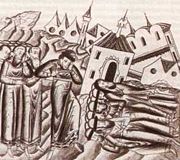
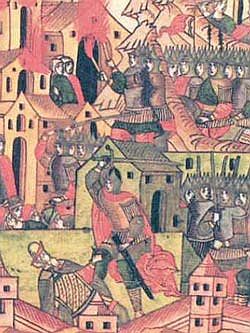
غزا باتو خان روسيا ثم حوض ڤولگا في بلغاريا الڤولگا أواخر عقد 1230، وقلص معظم إماراتها وجعلها مجرد إقطاعيات تابعة له، وبدأ بالضغط على شرق أوروبا، بالواقع هو كان جاهز لغزو غرب أوروبا خاصة بعد انتصاراته الباهرة وسحقه الجيوش البولندية، الألمانية والمجرية بمعركتي لجنيكا وموهي حيث جهز هو وسباتاي خان الجيوش لحملة الشتاء لغزو النمسا وألمانيا وإنهائها بإيطاليا حسب الخطة، لكن أخبار موت أوجاداي خان حول انتباه باتو خان عن أوروبا واتجه صوب العاصمة ومن سيتولى العرش المغولي، تلك كانت أعظم نقطة تحول بتاريخ أوروبا لأنها بالتأكيد سوف تقع تحت الحكم المنغولي لو استمر باتو خان بحملته.
حينما تمدد المغول داخل بولندا وظهر التهديد الخطير للنمسا بدا إنه لن يستطيعوا دخول أوروبا أكثر من ذلك، السبب الرئيسي حسب تحليلات المفسرين هو أنه خلال عمليات استطلاع للمغول داخل النمسا استعدادا لغزوها وصلتهم الأنباء بموت الإمبرطور أوجاداي خان بتاريخ 11 ديسمبر 1241. وحسب الأعراف المنغولية يجب على جميع القادة والزعماء التوجه إلى العاصمة قره قورم لإختيار خليفة للخان، كان الإعتقاد العام في أوروبا إن التوقف كان مؤقتا ولكن يبدو أن الخان الجديد له نظرة أخرى، حيث أن كانت عينه باتجاه الصين ولايريد التمدد على أوروبا. نجاح خطط سوبوتاي العسكرية المطبقة بأوروبا بشكل مدمر جعلت الإمبرطور جويوك يعيد تعيينه لقيادة الجيوش التي على الحدود الصينية.
غزو مملكة المجر
قوة وتأثير الجيوش الصينية المنتشرة كان شبه مدمر للمغول في حصارهم للمدن، فضلا عن التكتيكات كالتي طبقت في معركة موهي ضد المجر لا يمكنها التطبيق هنا بدون قائد فذ أو السلاح المطلوب وهنا كان اختيار سوبوتاي خان لقيادة الجيوش الشبه متعثرة بالصين. الغزوات المتكررة للقائد المغولي نوكاي خان بن باؤل بن جوشي بن جنكيز خان في أعوام 1284 و1285 و1287 وإن كانت أكثر وحشية وقتل وسوء نية للمدن الأوربية الغير محصنة إلا إنها لم تكن مثل نجاح سلفه سوبوتاي خان في اجتياح اوربا.
ظهر جليا أن النية لدى المغول هي اجتياح الصين وأخذها خاصة بعد موت مونكو خان 1259 ولذلك تم سحب الكثير من الوحدات العسكرية من الجبهة الغربية لدخول البوابة المجد الصعبة باجتياحهم مملكة سونج الصينية, بالواقع تلك الحرب المنغولية الصينية كانت من أكثر الحروب كلفة وخسائر بالأرواح بتاريخ الدولتين واستمرت قرابة 65 سنة.
الإجابة الواقعية لسبب توقف المغول بعد معركة موهي وتحطيمهم الجيش المجري هو عدم رغبتهم للذهاب أبعد من ذلك. فباتو خان قد كون مملكته في روسيا وأمنها لعشر أجيال لاحقة. وعند موت الخان رجع بسرعة إلى العاصمة ليطالب بالحكم, مماسبب بتدهور العلاقة مع ابن عمه جيوك خان ووصلت إلى مرحلة النزاع المسلح بينهما, بعد عام 1260 لم يستطع المغول توحيد جيوشهم للتوجه لآوربا أو مصر، فباتو خان كان يخطط للوصول للأطلسي أو البحر العظيم ولكنه مات عام 1255. وورث إبنه حكم القبيلة الذهبية ولكن لم يدم طويلا حتى مات ثم أتى بركه خان أخو باتو خان فقضى أكثر وقته بحرب ابن عمه هولاكو فهدأت الأحوال بأوربا بعد ذلك.
غزو مملكة كرواتيا
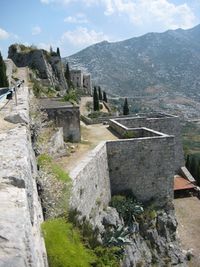
الوقع على الإمارات الرومانية
التكتيكات الأوروبية ضد المنغول
نشر المنغول للبارود الصيني في أوروبا
Several sources mention Chinese firearms and gunpowder weapons being deployed by the Mongols against European forces at the Battle of Mohi in various forms, including bombs hurled via catapult.[12][13][14] Professor Kenneth Warren Chase credits the Mongols for introducing gunpowder and its associated weaponry into Europe.[15]
A later legend arose in Europe about a mysterious Berthold Schwarz who is credited with the invention of gunpowder by 15th- through 19th-century European literature.[16]
نهاية التقدم المنغولي
في تاريخ الشعوب الناطقة بالإنگليزية، يقول ونستون تشرشل:
But Asia too was marching against the West. At one moment it had seemed as if all Europe would succumb to a terrible menace looming up from the East. Heathen Mongol hordes from the heart of Asia, formidable horsemen armed with bows, had rapidly swept over Russia, Poland, Hungary, and in 1241 inflicted simultaneous crushing defeats upon the Germans near Breslau and upon European cavalry near Buda. Germany and Austria at least lay at their mercy. Providentially in this year the Great Khan died in Mongolia; the Mongol leaders hastened back the thousands of miles to Karakorum, their capital, to elect his successor, and Western Europe escaped.[17]
الحملات اللاحقة
حملات القبيل الذهبي في ع1280 (those in Bulgaria, Hungary, and Poland), were much greater in scale than any campaign since the 1241-1242 invasion, due to the lack of civil war in the Mongol Empire at the time. They have sometimes been collectively referred to as "the second Mongol invasion of Europe", or "the second Tatar-Mongol invasion of central and south-eastern Europe".[18]
ضد پولندا (1259 و 1287)
ضد تراقيا البيزنطية (1265, 1324 و 1337)
ضد بلغاريا (1241, 1242, 1271, 1274, 1280 و 1285)
ضد المجر (1285)
المقال الرئيسي: الغزو المنغولي الثاني للمجر
ضد صربيا (1291)
In 1291 a large Mongol-Bulgarian alliance raided into Serbia, where Serbian king Stefan Uroš II Milutin defeated them. However, the Serbian king acknowledged Nogai's supremacy and sent his son as hostage to prevent further hostility when Nogai threatened to lead a punitive expedition himself.[19]
خرائط
معرض صور
Golden Horde raid at Ryazan
Golden Horde raid at Kiev
Golden Horde raid at Kozelsk
Golden Horde raid Vladimir
Golden Horde raid Suzdal
The Hungarian King Béla IV on the flight from the Mongols under general Kadan of the Golden Horde.
انظر أيضاً
الهامش
- ^ Sources vary, with estimates of Mongol forces from 10,000 to 50,000.
- ^ Carey states on p. 128 that Batu had 40,000 in the main body and ordered Subutai to take 30,000 troops in an encircling maneuver. Batu commanded the central prong of the Mongols' three-pronged assault on Europe. This number seems correct when compared with the numbers reported at the Battles of Leignitz to the north and Hermannstadt (سيبيو) to the south. All three victories occurred in the same week.
- ^ أ ب Markó, László (2000). Great Honours of the Hungarian State. Budapest: Magyar Könyvklub. ISBN 963-547-085-1
{{cite book}}: CS1 maint: postscript (link) - ^ أ ب ت ث Liptai, Ervin (1985). Military history of Hungary. Budapest: Zrínyi Katonai Kiadó. ISBN 963-326-337-9
{{cite book}}: CS1 maint: postscript (link) - ^ René Grousset The Empire of Steppes
- ^ Carey, Brian Todd, p. 124
- ^ Colin McEvedy, Atlas of World Population History (1978)
- ^ Thomas T. Allsen. Culture and Conquest in Mongol Eurasia. Cambridge UP.
- ^ Brian Landers (2011). Empires Apart: A History of American and Russian Imperialism. Open Road Media. p. 17.
- ^ Diana Lary (2012). Chinese Migrations: The Movement of People, Goods, and Ideas over Four Millennia. Rowman & Littlefield. p. 49.
- ^ Francis Dvornik (1962). The Slavs in European History and Civilization. Rutgers UP. p. 26.
- ^ Michael Kohn (2006). Dateline Mongolia: An American Journalist in Nomad's Land. RDR Books. p. 28. ISBN 1-57143-155-1. Retrieved 2011-07-29.
- ^ William H. McNeill (1992). The Rise of the West: A History of the Human Community. University of Chicago Press. p. 492. ISBN 0-226-56141-0. Retrieved 2011-07-29.
- ^ Robert Cowley (1993). Robert Cowley (ed.). Experience of War (reprint ed.). Random House Inc. p. 86. ISBN 0-440-50553-4. Retrieved 2011-07-29.
- ^ Kenneth Warren Chase (2003). Firearms: a global history to 1700 (illustrated ed.). Cambridge University Press. p. 58. ISBN 0-521-82274-2. Retrieved 2011-07-29.
- ^ Kelly (2005), p.23
- ^ Sir Winston Churchill, Winston Spencer Churchill (1999). Sir Winston Churchill, Winston Spencer Churchill (ed.). The great republic: a history of America. Random House. p. 7. ISBN 0-375-50320-X. Retrieved 2011-11-28.
But Asia too was marching against the West. At one moment it had seemed as if all Europe would succumb to a terrible menace looming up from the East. Heathen Mongol hordes from the heart of Asia, formidable horsemen armed with bows, had rapidly swept over Russia, Poland, Hungary, and in 1241 inflicted simultaneous crushing defeats upon the Germans near Breslau and upon European cavalry near Buda. Germany and Austria at least lay at their mercy.
{{cite book}}: Cite has empty unknown parameter:|month=(help) - ^ Peter Jackson, "The Mongols and the West", 2005. Page 199
- ^ István Vásáry Cumans and Tatars: Oriental military in the pre-Ottoman Balkans, 1185-1365, p.89
مراجع
للاستزادة
- Allsen, Thomas T. Culture and Conquest in Mongol Eurasia. Cambridge UP.
- Atwood, Christopher P. Encyclopedia of Mongolia and the Mongol Empire (2004)
- Chambers, James. The Devil's Horsemen: The Mongol Invasion of Europe (London: Weidenfeld and Nicolson, 1979)
- Christian, David. A History of Russia, Central Asia and Mongolia Vol. 1: Inner Eurasia from Prehistory to the Mongol Empire (Blackwell, 1998)
- Cook, David, "Apocalyptic Incidents during the Mongol Invasions", in Brandes, Wolfram / Schmieder, Felicitas (hg), Endzeiten. Eschatologie in den monotheistischen Weltreligionen (Berlin, de Gruyter, 2008) (Millennium-Studien / Millennium Studies / Studien zu Kultur und Geschichte des ersten Jahrtausends n. Chr. / Studies in the Culture and History of the First Millennium C.E., 16), 293-312.
- Halperin, Charles J. Russia and the golden horde: the Mongol impact on medieval Russian history (Indiana University Press, 1985)
- May, Timothy. The Mongol conquests in world history (Reaktion Books, 2013)
- Morgan, David. The Mongols, ISBN 0-631-17563-6
- Nicolle, David. The Mongol Warlords, Brockhampton Press, 1998
- Reagan, Geoffry. The Guinness Book of Decisive Battles, Canopy Books, New York (1992)
- Saunders, J.J. The History of the Mongol Conquests, Routledge & Kegan Paul Ltd, 1971, ISBN 0-8122-1766-7
- Sinor, Denis (1999). "The Mongols in the West". Journal of Asian History. 33 (1).; also in JSTOR
- Vernadsky, George. The Mongols and Russia (Yale University Press, 1953)
- Halperin, Charles J. "George Vernadsky, Eurasianism, the Mongols, and Russia." Slavic Review (1982): 477-493. in JSTOR
وصلات خارجية
- مقالات بأسلوب استشهاد غير متناسق
- CS1 maint: postscript
- Articles with hatnote templates targeting a nonexistent page
- Pages using div col with unknown parameters
- Expeditionary warfare
- غزوات الإمبراطورية المنغولية
- غزو أوروپا
- العصور الوسطى العليا
- نزاعات القرن 13
- حروب المنغول
- التاريخ العسكري لمنغوليا
- History of Poland (966–1385)
- مولدوڤا في العصور الوسطى المبكرة
- Romania in the Early Middle Ages
- 13th century in the Mongol Empire
- Military history of the Teutonic Order
